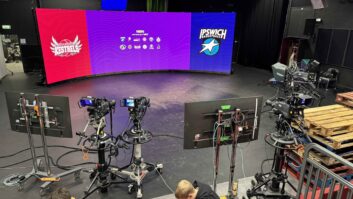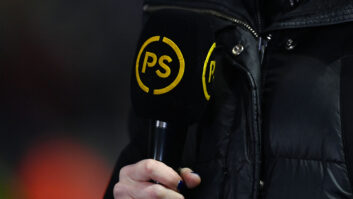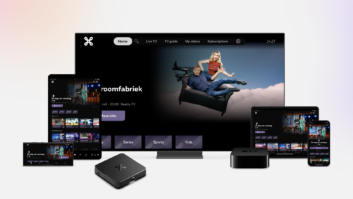
Richard Halton (pictured), CEO of the delayed YouView (formerly Canvass) consortium, announced at last Friday’s DTG AGM/conference that the core technical specification for the internet-connected Freeview TV platform is to be finalised on 14 April, writes Richard Dean.
The API (Application Programming Interface) will also be available from that date on the consortium’s website (link below) for manufacturers wishing to use a subset of features, thus facilitating deployment internationally. YouView technical details were previously available only to DTG (Digital TV Group) members.
Halton added that the standard will be closely integrated with the DTG’s impending ‘Connected TV’ D-Book 7 specification, which will include all the technical requirements for the new BBC iPlayer v.3. Comprising Arqiva, the BBC, BT, Channel 4, Five, ITV and Talk Talk Group, as well as hardware partners Cisco, Humax and Technicolor, the YouView consortium plans to release a working prototype by the end of this year prior to commercial launch early next.
In the meantime several CE manufacturers have launched their own competing versions of connected viewing including Sony Bravia Internet Video, Samsung Apps and Panasonic Viera Connect alongside a variety of well established HbbTV (Hybrid broadband TV) implementations across continental Europe.
John Bird of Futuresource Consulting predicted that the number of internet-connectable consumer devices will jump from the current 6% to 60% by 2014, stressing that connectivity was not necessarily the same as usage.
Indeed, Roly Keating, director of archive content at the BBC, said that today only 40% of connectable devices were actually connected, although he believes this will increase dramatically. “We need to combine skills to re-invent the experience of pressing the Red Button to offer a ‘Dynamic Bridge’ that responds to what the viewer is watching,” he said.
This raised the issue of how to prevent the selection of web-based opt-outs, checking email or participating in social networks (supported by iPlayer v.3) from disrupting others during group viewing at home.
Keating said that restricted gateways would ensure that all added-value content was closely relevant to linear content, while many believed that the best place for such material was on a new breed of TV-synchronised smartphones rather than the main screen.
The conference agreed that for connected TV to work for mainstream viewing, the industry must overcome lingering fears over viruses and inappropriate content. Otherwise, in the words of The Association for TV on Demand’s CEO Peter Johnson, TV could lose its reputation as a ‘safe babysitting medium’ forever.
www.youview.com/developer-zone
Richard Halton (pictured), CEO of the delayed YouView (formerly Canvass) consortium, announced at last Friday’s DTG AGM/conference that the core technical specification for the internet-connected Freeview TV platform is to be finalised on 14 April, writes Richard Dean.
The API (Application Programming Interface) will also be available from that date on the consortium’s website (link below) for manufacturers wishing to use a subset of features, thus facilitating deployment internationally. YouView technical details were previously available only to DTG (Digital TV Group) members.
Halton added that the standard will be closely integrated with the DTG’s impending ‘Connected TV’ D-Book 7 specification, which will include all the technical requirements for the new BBC iPlayer v.3. Comprising Arqiva, the BBC, BT, Channel 4, Five, ITV and Talk Talk Group, as well as hardware partners Cisco, Humax and Technicolor, the YouView consortium plans to release a working prototype by the end of this year prior to commercial launch early next.
In the meantime several CE manufacturers have launched their own competing versions of connected viewing including Sony Bravia Internet Video, Samsung Apps and Panasonic Viera Connect alongside a variety of well established HbbTV (Hybrid broadband TV) implementations across continental Europe.
John Bird of Futuresource Consulting predicted that the number of internet-connectable consumer devices will jump from the current 6% to 60% by 2014, stressing that connectivity was not necessarily the same as usage.
Indeed, Roly Keating, director of archive content at the BBC, said that today only 40% of connectable devices were actually connected, although he believes this will increase dramatically. “We need to combine skills to re-invent the experience of pressing the Red Button to offer a ‘Dynamic Bridge’ that responds to what the viewer is watching,” he said.
This raised the issue of how to prevent the selection of web-based opt-outs, checking email or participating in social networks (supported by iPlayer v.3) from disrupting others during group viewing at home.
Keating said that restricted gateways would ensure that all added-value content was closely relevant to linear content, while many believed that the best place for such material was on a new breed of TV-synchronised smartphones rather than the main screen.
The conference agreed that for connected TV to work for mainstream viewing, the industry must overcome lingering fears over viruses and inappropriate content. Otherwise, in the words of The Association for TV on Demand’s CEO Peter Johnson, TV could lose its reputation as a ‘safe babysitting medium’ forever.







